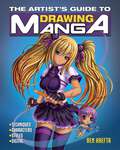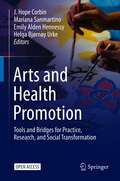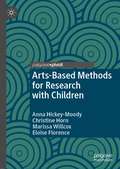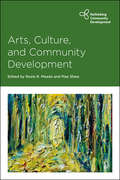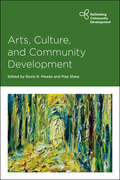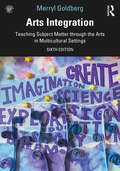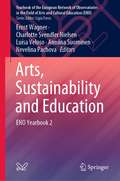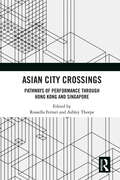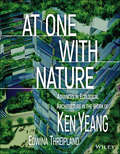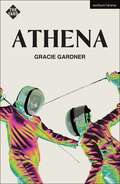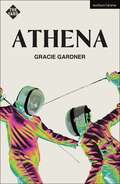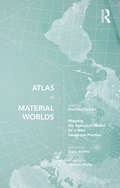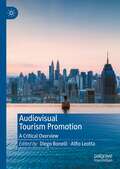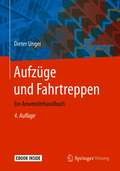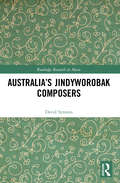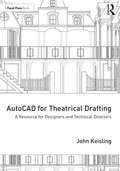- Table View
- List View
The Artist's Guide to Drawing Manga
by Ben KreftaImmerse yourself in the dynamic world of Japanese manga drawing with this inspirational drawing book. Master manga artist Ben Krefta guides you through a variety of exciting character designs, from 'Mecha' robots to 'Shinobi' ninjas. He also provides you will a toolkit of techniques, including:• Constructing manga eyes• Portraying movement and using speed lines • Creating manga's distinctive facial expressions• Designing clothes, weapons and accessories• Drawing a manga comic stripEach lesson is broken down into step-by-step components, so seemingly complex artworks are easy to achieve. This full-colour workbook celebrates the originality and diversity of different manga styles and provides you with the tools to bring your own characters to life.
Arts and Health Promotion: Tools and Bridges for Practice, Research, and Social Transformation
by J. Hope Corbin Mariana Sanmartino Emily Alden Hennessy Helga Bjørnøy UrkeThis open access book offers an overview of the beautiful, powerful, and dynamic array of opportunities to promote health through the arts from theoretical, methodological, pedagogical, and critical perspectives. This is the first-known text to connect the disparate inter-disciplinary literatures into a coherent volume for health promotion practitioners, researchers, and teachers. It provides a one-stop depository for using the arts as tools for health promotion in many settings and as bridges across communities, cultures, and sectors. The diverse applications of the arts in health promotion transcend the multiple contexts within which health is created, i.e., individual, community, and societal levels, and has a number of potential health, aesthetic, and social outcomes. Topics covered within the chapters include: Exploring the Potential of the Arts to Promote Health and Social Justice Drawing as a Salutogenic Therapy Aid for Grieving Adolescents in Botswana Community Theater for Health Promotion in Japan From Arts to Action: Project SHINE as a Case Study of Engaging Youth in Efforts to Develop Sustainable Water, Sanitation, and Hygiene Strategies in Rural Tanzania and India Movimiento Ventana: An Alternative Proposal to Mental Health in Nicaragua Using Art to Bridge Research and Policy: An Initiative of the United States National Academy of Medicine Arts and Health Promotion is an innovative and engaging resource for a broad audience including practitioners, researchers, university instructors, and artists. It is an important text for undergraduate- and graduate-level courses, particularly in program planning, research methods (especially qualitative methodology), community health, and applied art classes. The book also is useful for professional development among current health promotion practitioners, community nurses, community psychologists, public health professionals, and social workers.
Arts-Based Methods for Research with Children (Studies in Childhood and Youth)
by Anna Hickey-Moody Christine Horn Marissa Willcox Eloise FlorenceThis book offers a practical, methodological guide to conducting arts-based research with children by drawing on five years of the authors’ experience carrying out arts-based research with children in Australia and the UK. Based on the Australian Research Council-funded Interfaith Childhoods project, the authors describe methods of engaging communities and making data with children that foreground children’s experiences and worldviews through making, being with, and viewing art. Framing these methods of doing, seeing, being, and believing through art as modes of understanding children’s strategies for negotiating personal identities and values, this book explores the value of arts-based research as a means of obtaining complex information about children’s life worlds that can be difficult to express verbally.
Arts, Culture and Community Development (Rethinking Community Development)
by Rosie R. Meade and Mae ShawHow and why are arts and cultural practices meaningful to communities? Highlighting examples from Lebanon, Latin America, China, Ireland, India, Sri Lanka and beyond, this exciting book explores the relationship between the arts, culture and community development. Academics and practitioners from six continents discuss how diverse communities understand, re-imagine or seek to change personal, cultural, social, economic or political conditions while using the arts as their means and spaces of engagement. Investigating the theory and practice of ‘cultural democracy’, this book explores a range of aesthetic forms including song, music, muralism, theatre, dance, and circus arts.
Arts, Culture and Community Development (Rethinking Community Development)
by Rosie Meade Mae ShawHow and why are arts and cultural practices meaningful to communities? Highlighting examples from Lebanon, Latin America, China, Ireland, India, Sri Lanka and beyond, this exciting book explores the relationship between the arts, culture and community development. Academics and practitioners from six continents discuss how diverse communities understand, re-imagine or seek to change personal, cultural, social, economic or political conditions while using the arts as their means and spaces of engagement. Investigating the theory and practice of ‘cultural democracy’, this book explores a range of aesthetic forms including song, music, muralism, theatre, dance, and circus arts.
Arts Integration: Teaching Subject Matter through the Arts in Multicultural Settings
by Merryl GoldbergNow in its sixth edition, Merryl Goldberg’s popular volume Arts Integration presents a comprehensive guide to integrating the arts throughout the K-12 curriculum, blending contemporary theory with classroom practice. Beyond teaching about arts education as a subject in and of itself, the text explains how teachers may integrate the arts—literary, media, visual, and performing—throughout the subject curriculum, offering a wealth of strategies, techniques, and examples. Promoting ways to develop children’s creativity and critical thinking while also developing communications skills and fostering collaboration and community activism, Arts Integration explores assessment and the arts, engaging English Language Learners, and using the arts to teach academic skills in science, math, history, and more. This text is ideal as a primer on arts integration and a foundational support for teaching, learning, and assessment, especially within the context of multicultural and multilingual classrooms. In-depth discussions of the role of arts integration in meeting the goals of Title I programs, including academic achievement, student engagement, school climate, and parental involvement, are woven throughout the text, as is the role of the arts in nurturing Creative Youth Development work and its importance to the community. This revised and updated sixth edition combines a social justice emphasis with templates for developing lesson plans and units, updated coverage on STEAM education, along with brand new examples, case studies, and research. An expanded range of eResources is also available for this edition, including links to further resources readings, additional imagery and videos, and sample lesson plans.
Arts Integration: Teaching Subject Matter through the Arts in Multicultural Settings
by Merryl GoldbergNow in its sixth edition, Merryl Goldberg’s popular volume Arts Integration presents a comprehensive guide to integrating the arts throughout the K-12 curriculum, blending contemporary theory with classroom practice. Beyond teaching about arts education as a subject in and of itself, the text explains how teachers may integrate the arts—literary, media, visual, and performing—throughout the subject curriculum, offering a wealth of strategies, techniques, and examples. Promoting ways to develop children’s creativity and critical thinking while also developing communications skills and fostering collaboration and community activism, Arts Integration explores assessment and the arts, engaging English Language Learners, and using the arts to teach academic skills in science, math, history, and more. This text is ideal as a primer on arts integration and a foundational support for teaching, learning, and assessment, especially within the context of multicultural and multilingual classrooms. In-depth discussions of the role of arts integration in meeting the goals of Title I programs, including academic achievement, student engagement, school climate, and parental involvement, are woven throughout the text, as is the role of the arts in nurturing Creative Youth Development work and its importance to the community. This revised and updated sixth edition combines a social justice emphasis with templates for developing lesson plans and units, updated coverage on STEAM education, along with brand new examples, case studies, and research. An expanded range of eResources is also available for this edition, including links to further resources readings, additional imagery and videos, and sample lesson plans.
Arts, Sustainability and Education: ENO Yearbook 2 (Yearbook of the European Network of Observatories in the Field of Arts and Cultural Education (ENO))
by Luísa Veloso Charlotte Svendler Nielsen Ernst Wagner Anniina Suominen Nevelina PachovaThis book explores the potential of arts and cultural education to contribute to on-going efforts to promote Education for Sustainable Development (ESD) in line with UNESCO’s conceptualizations of the field. It builds on the experiences of arts educators working to build sustainable futures and portrays new and innovative approaches. Chapters comprise case studies that combine arts, culture, sustainable thinking and practices. They also include research from historical perspectives, evaluations of public policy measures and offer theoretical approaches and methodologies. The book unfolds the possible relationships between arts and cultural education and Education for Sustainable Development.
Asian Art Therapists: Navigating Art, Diversity, and Culture
by Megu KitazawaThis book explores Asian art therapist experiences in a predominantly white professional field, challenging readers with visceral, racial, and personalized stories that may push them far beyond their comfort zone. Drawing from the expertise and practices of Asian art therapists from around the world, this unique text navigates how minority status can affect training and clinical practice in relation to clients, co-workers, and peers. It describes how Asian pioneers have broken therapeutic and racial rules to accommodate patient needs and improve clinical skills and illustrates how the reader can examine and disseminate their own biases. Authors share how they make their own path—by becoming aware of the connection between their lives and circumstances—and how they liberate themselves and those who seek their services. This informative resource for art therapy students and professionals offers non-Asian readers a glimpse at personal and clinical experiences in the White-dominant profession while detailing how Asian art therapists can lead race-based discussions with empathy to become more competent therapists and educators in an increasingly diversifying world.
Asian Art Therapists: Navigating Art, Diversity, and Culture
by Megu KitazawaThis book explores Asian art therapist experiences in a predominantly white professional field, challenging readers with visceral, racial, and personalized stories that may push them far beyond their comfort zone. Drawing from the expertise and practices of Asian art therapists from around the world, this unique text navigates how minority status can affect training and clinical practice in relation to clients, co-workers, and peers. It describes how Asian pioneers have broken therapeutic and racial rules to accommodate patient needs and improve clinical skills and illustrates how the reader can examine and disseminate their own biases. Authors share how they make their own path—by becoming aware of the connection between their lives and circumstances—and how they liberate themselves and those who seek their services. This informative resource for art therapy students and professionals offers non-Asian readers a glimpse at personal and clinical experiences in the White-dominant profession while detailing how Asian art therapists can lead race-based discussions with empathy to become more competent therapists and educators in an increasingly diversifying world.
Asian City Crossings: Pathways of Performance through Hong Kong and Singapore
by Rossella Ferrari; Ashley ThorpeAsian City Crossings is the first volume to examine the relationship between the city and performance from an Asian perspective. This collection introduces "city as method" as a new conceptual framework for the investigation of practices of city-based performing arts collaboration and city-to-city performance networks across East- and Southeast Asia and beyond. The shared and yet divergent histories of the global cities of Hong Kong and Singapore as postcolonial, multiethnic, multicultural, and multilingual sites, are taken as points of departure to demonstrate how "city as method" facilitates a comparative analytical space that foregrounds in-betweenness and fluid positionalities. It situates inter-Asian relationality and inter-city referencing as centrally significant dynamics in the exploration of the material and ideological conditions of contemporary performance and performance exchange in Asia. This study captures creative dialogue that travels city-based pathways along the Hong Kong-Singapore route, as well as between Hong Kong and Singapore and other cities, through scholarly analyses and practitioner reflections drawn from the fields of theatre, performance, and music. This book combines essays by scholars of Asian studies, theatre studies, ethnomusicology, and human geography with reflective accounts by Hong Kong and Singapore-based performing arts practitioners to highlight the diversity, vibrancy, and complexity of creative projects that destabilise notions of identity, belonging, and nationhood through strategies of collaborative conviviality and transnational mobility across multi-sited networks of cities in Asia. In doing so, this volume fills a considerable gap in global scholarly discourse on performance and the city and on the production and circulation of the performing arts in Asia.
Asian City Crossings: Pathways of Performance through Hong Kong and Singapore
by Rossella Ferrari Ashley ThorpeAsian City Crossings is the first volume to examine the relationship between the city and performance from an Asian perspective. This collection introduces "city as method" as a new conceptual framework for the investigation of practices of city-based performing arts collaboration and city-to-city performance networks across East- and Southeast Asia and beyond. The shared and yet divergent histories of the global cities of Hong Kong and Singapore as postcolonial, multiethnic, multicultural, and multilingual sites, are taken as points of departure to demonstrate how "city as method" facilitates a comparative analytical space that foregrounds in-betweenness and fluid positionalities. It situates inter-Asian relationality and inter-city referencing as centrally significant dynamics in the exploration of the material and ideological conditions of contemporary performance and performance exchange in Asia. This study captures creative dialogue that travels city-based pathways along the Hong Kong-Singapore route, as well as between Hong Kong and Singapore and other cities, through scholarly analyses and practitioner reflections drawn from the fields of theatre, performance, and music. This book combines essays by scholars of Asian studies, theatre studies, ethnomusicology, and human geography with reflective accounts by Hong Kong and Singapore-based performing arts practitioners to highlight the diversity, vibrancy, and complexity of creative projects that destabilise notions of identity, belonging, and nationhood through strategies of collaborative conviviality and transnational mobility across multi-sited networks of cities in Asia. In doing so, this volume fills a considerable gap in global scholarly discourse on performance and the city and on the production and circulation of the performing arts in Asia.
At One with Nature: Advances in Ecological Architecture in the Work of Ken Yeang
by Ken Yeang Edwina Threipland“At One with Nature is an inspiring collection of the latest work of Ken Yeang that further advances sustainable architecture and design. This collection features recent projects as he explores how we can achieve harmony between the natural and our built environments to create a better planet by design. Each project features and highlights not only the systems and devices adopted, but also outlines the intentions and ecological considerations demonstrating best practices for how we can proceed moving forward. The book role models our living Earth and shows how we can behave as stewards of our planet.” --Cassia Patel, Oceanic Global Foundation At One with Nature showcases Ken Yeang’s latest ideas, built projects designs, research work and advances in the field of designing with nature, a topic that Yeang has pioneered and developed over many decades since receiving his doctorate in ecological design and planning from Cambridge University. His ideas and work are even more pertinent today with the current state of devastation of Earth’s natural systems and a biogeochemical cycle that has been extensively and severely impacted by human society. The global environment today is in a state of crisis, but what can society do to address the issues? Yeang’s recent projects are presented with instructive diagrams that provide a basis for action for architects, planners, designers, engineers, and anyone whose daily work impinges on the natural environment. Offered in a highly visual, annotated format, with instructive illustrations of Yeang’s theoretical books on the topic, At One with Nature is an invaluable resource that students and academics interested in designing with nature will find both informative and relevant.
At One with Nature: Advances in Ecological Architecture in the Work of Ken Yeang
by Ken Yeang Edwina Threipland"At One with Nature is an inspiring collection of the latest work of Ken Yeang that further advances sustainable architecture and design. This collection features recent projects as he explores how we can achieve harmony between the natural and our built environments to create a better planet by design. Each project features and highlights not only the systems and devices adopted, but also outlines the intentions and ecological considerations demonstrating best practices for how we can proceed moving forward. The book role models our living Earth and shows how we can behave as stewards of our planet."--Cassia Patel, Oceanic Global Foundation At One with Nature showcases Ken Yeang's latest ideas, built projects designs, research work and advances in the field of designing with nature, a topic that Yeang has pioneered and developed over many decades since receiving his doctorate in ecological design and planning from Cambridge University. His ideas and work are even more pertinent today with the current state of devastation of Earth's natural systems and a biogeochemical cycle that has been extensively and severely impacted by human society. The global environment today is in a state of crisis, but what can society do to address the issues? Yeang's recent projects are presented with instructive diagrams that provide a basis for action for architects, planners, designers, engineers, and anyone whose daily work impinges on the natural environment. Offered in a highly visual, annotated format, with instructive illustrations of Yeang's theoretical books on the topic, At One with Nature is an invaluable resource that students and academics interested in designing with nature will find both informative and relevant.
Athena (Modern Plays)
by Gracie GardnerWhy Athena? I guess just like the goddess of strategic warfare and all that. In a New York City fencing club two warriors are ready to battle. Athena and Mary Wallace are training for the Junior Olympics. They practice together. They compete against each other. They spend their lives together. They wish they were friends. From Award-winning playwright Gracie Gardner, following an acclaimed extended run in New York, comes a fierce coming of age comedy where two teenagers parry class, competition and power as they practice fencing and life. But only one will win - en garde. This edition was published to coincide with the UK premiere at The Yard in London in October 2021.
Athena (Modern Plays)
by Gracie GardnerWhy Athena? I guess just like the goddess of strategic warfare and all that. In a New York City fencing club two warriors are ready to battle. Athena and Mary Wallace are training for the Junior Olympics. They practice together. They compete against each other. They spend their lives together. They wish they were friends. From Award-winning playwright Gracie Gardner, following an acclaimed extended run in New York, comes a fierce coming of age comedy where two teenagers parry class, competition and power as they practice fencing and life. But only one will win - en garde. This edition was published to coincide with the UK premiere at The Yard in London in October 2021.
Atlas of Material Worlds: Mapping the Agency of Matter for a New Landscape Practice
by Matthew SeibertAtlas of Material Worlds is a highly designed narrative atlas illustrating the agency of nonliving materials with unique, ubiquitous, and often hidden influence on our daily lives. Employing new materialism as a jumping-off point, it examines the increasingly blurry lines between the organic and inorganic, engaging the following questions: What roles do nonliving materials play? Might a closer examination of those roles reveal an undeniable agency we have long overlooked or disregarded? If so, does this material agency change our understanding of the social structures, ecologies, economies, cosmologies, technologies, and landscapes that surround us? And, perhaps most importantly, why does material agency matter? This is the story of the world’s driest nonpolar desert, pink flamingos, and cerulean blue lithium ponds; industrial shipping logistics, pudding-like jiggling substrates, and monuments of mud; galactic bodies, radioactive sheep, and the yellowcake of uranium. Put simply, this book dares readers to see the world anew, from material up. Atlas of Material Worlds offers this new relationship to our host environment in a time of mounting crises—accelerating climate change, ballooning socioeconomic inequality, and rising toxic nationalism—uniquely telling materialist stories for practitioners and students in landscape, architecture, and other built environment disciplines.
Atlas of Material Worlds: Mapping the Agency of Matter for a New Landscape Practice
by Matthew SeibertAtlas of Material Worlds is a highly designed narrative atlas illustrating the agency of nonliving materials with unique, ubiquitous, and often hidden influence on our daily lives. Employing new materialism as a jumping-off point, it examines the increasingly blurry lines between the organic and inorganic, engaging the following questions: What roles do nonliving materials play? Might a closer examination of those roles reveal an undeniable agency we have long overlooked or disregarded? If so, does this material agency change our understanding of the social structures, ecologies, economies, cosmologies, technologies, and landscapes that surround us? And, perhaps most importantly, why does material agency matter? This is the story of the world’s driest nonpolar desert, pink flamingos, and cerulean blue lithium ponds; industrial shipping logistics, pudding-like jiggling substrates, and monuments of mud; galactic bodies, radioactive sheep, and the yellowcake of uranium. Put simply, this book dares readers to see the world anew, from material up. Atlas of Material Worlds offers this new relationship to our host environment in a time of mounting crises—accelerating climate change, ballooning socioeconomic inequality, and rising toxic nationalism—uniquely telling materialist stories for practitioners and students in landscape, architecture, and other built environment disciplines.
Audiovisual Tourism Promotion: A Critical Overview
by Alfio Leotta Diego BonelliThis book deploys the concept of ‘audiovisual tourism promotion’ to account for the promotional functions performed by a vast array of diverse media texts including tourism films, feature films, digital videos conceived for online circulation, video games and TV commercials. From this point of view, this volume fills a major gap in the literature by providing the first comprehensive critical overview of audiovisual tourism promotion as a distinct media field. In this book, the study of audiovisual tourism promotion is characterised by an interdisciplinary approach which combines film studies, media studies, human geography, sociology, tourism studies, history, postcolonial and gender studies. This book will appeal to a wide range of students and scholars from different disciplines.
Aufzüge und Fahrtreppen: Ein Anwenderhandbuch
by Dieter UngerIn der aktuellen Auflage bietet dieses Fachbuch für alle, die Fahrtreppen und Aufzüge planen, bauen oder betreiben, einen umfassenden Überblick zu allen wichtigen Fragen: angefangen bei den Normen und technischen Regeln bis hin zur Technikgeschichte. Es werden Planung, Betrieb, Wartung und Dokumentation von Aufzügen und Fahrtreppen beschrieben. Zahlreiche aussagekräftige farbige Abbildungen ergänzen den Text. Für die vierte Auflage wurden die Kapitel zu nationalen und internationalen Richtlinien auf den aktuellen Stand gebracht. Sie wurden neu strukturiert und weitere ISO Normen aufgenommen.Das Buch dient Betreibern von Aufzügen und Fahrtreppen als Nachschlagewerk. Die vielen Beispiele, Tipps und Ratschläge aus der Praxis machen es zu einem hilfreichen Begleiter bei der täglichen Arbeit.
Australian Genre Film (Routledge Advances in Film Studies)
by Kelly McWilliam Mark David RyanAustralian Genre Film interrogates key genres at the core of Australia’s so-called new golden age of genre cinema, establishing the foundation on which more sustained research on film genre in Australian cinema can develop. The book examines what characterises Australian cinema and its output in this new golden age, as contributors ask to what extent Australian genre film draws on widely understood (and largely Hollywood-based) conventions, as compared to culturally specific conventions of genre storytelling. As such, this book offers a comprehensive and up-to-date survey of Australian genre film, undertaken through original analyses of 13 significant Australian genres: action, biopics, comedy, crime, horror, musical, road movie, romance, science fiction, teen, thriller, war, and the Western. This book will be a cornerstone work for the burgeoning field of Australian film genre studies and a must-read for academics; researchers; undergraduate students; postgraduate students; and general readers interested in film studies, media studies, cultural studies, Australian studies, and sociology.
Australian Genre Film (Routledge Advances in Film Studies)
by Kelly McWilliamAustralian Genre Film interrogates key genres at the core of Australia’s so-called new golden age of genre cinema, establishing the foundation on which more sustained research on film genre in Australian cinema can develop. The book examines what characterises Australian cinema and its output in this new golden age, as contributors ask to what extent Australian genre film draws on widely understood (and largely Hollywood-based) conventions, as compared to culturally specific conventions of genre storytelling. As such, this book offers a comprehensive and up-to-date survey of Australian genre film, undertaken through original analyses of 13 significant Australian genres: action, biopics, comedy, crime, horror, musical, road movie, romance, science fiction, teen, thriller, war, and the Western. This book will be a cornerstone work for the burgeoning field of Australian film genre studies and a must-read for academics; researchers; undergraduate students; postgraduate students; and general readers interested in film studies, media studies, cultural studies, Australian studies, and sociology.
Australia’s Jindyworobak Composers (Routledge Research in Music)
by David SymonsAustralia’s Jindyworobak Composers examines the music of a historically and artistically significant group of Australian composers active during the later post-colonial period (1930s–c. 1960). These composers sought to establish a uniquely Australian identity through the evocation of the country’s landscape and environment, including notably the use of Aboriginal elements or imagery in their music, texts, dramatic scenarios or ‘programmes’. Nevertheless, it must be observed that this word was originally adopted as a manifesto for an Australian literary movement, and was, for the most part, only retrospectively applied by commentators (rather than the composers themselves) to art music that was seen to share similar aesthetic aims. Chapter One demonstrates to what extent a meaningful relationship may or may not be discernible between the artistic tenets of Jindyworobak writers and apparently likeminded composers. In doing so, it establishes the context for a full exploration of the music of Australian composers to whom ‘Jindyworobak’ has come to be popularly applied. The following chapters explore the music of composers writing within the Jindyworobak period itself and, finally, the later twentieth-century afterlife of Jindyworobakism. This will be of particular interest to scholars and researchers of Ethnomusicology, Australian Music and Music History.
Australia’s Jindyworobak Composers (Routledge Research in Music)
by David SymonsAustralia’s Jindyworobak Composers examines the music of a historically and artistically significant group of Australian composers active during the later post-colonial period (1930s–c. 1960). These composers sought to establish a uniquely Australian identity through the evocation of the country’s landscape and environment, including notably the use of Aboriginal elements or imagery in their music, texts, dramatic scenarios or ‘programmes’. Nevertheless, it must be observed that this word was originally adopted as a manifesto for an Australian literary movement, and was, for the most part, only retrospectively applied by commentators (rather than the composers themselves) to art music that was seen to share similar aesthetic aims. Chapter One demonstrates to what extent a meaningful relationship may or may not be discernible between the artistic tenets of Jindyworobak writers and apparently likeminded composers. In doing so, it establishes the context for a full exploration of the music of Australian composers to whom ‘Jindyworobak’ has come to be popularly applied. The following chapters explore the music of composers writing within the Jindyworobak period itself and, finally, the later twentieth-century afterlife of Jindyworobakism. This will be of particular interest to scholars and researchers of Ethnomusicology, Australian Music and Music History.
AutoCAD for Theatrical Drafting: A Resource for Designers and Technical Directors
by John KeislingAutoCAD for Theatrical Drafting provides an introduction to the software AutoCAD, specifically focusing on how to navigate the commands most commonly used when creating design, construction and installation drafting plates for theatrical use. Beginning with a step-by-step tutorial of how to download the program and a review of theatrical drafting standards, the text details commands used in 2D drafting and 3D modeling and how to create theatrical drafting plates using AutoCAD that meet those drafting standards. It also provides guidance on how to transition from 2D drafting to 3D modeling, how to use 3D models to create camera views and animations and how to use 3D models for production and engineering purposes. Intended as a resource for the beginning and intermediate AutoCAD user, AutoCAD for Theatrical Drafting provides easy-to-follow instructions that readers can refer to while using the AutoCAD software.
